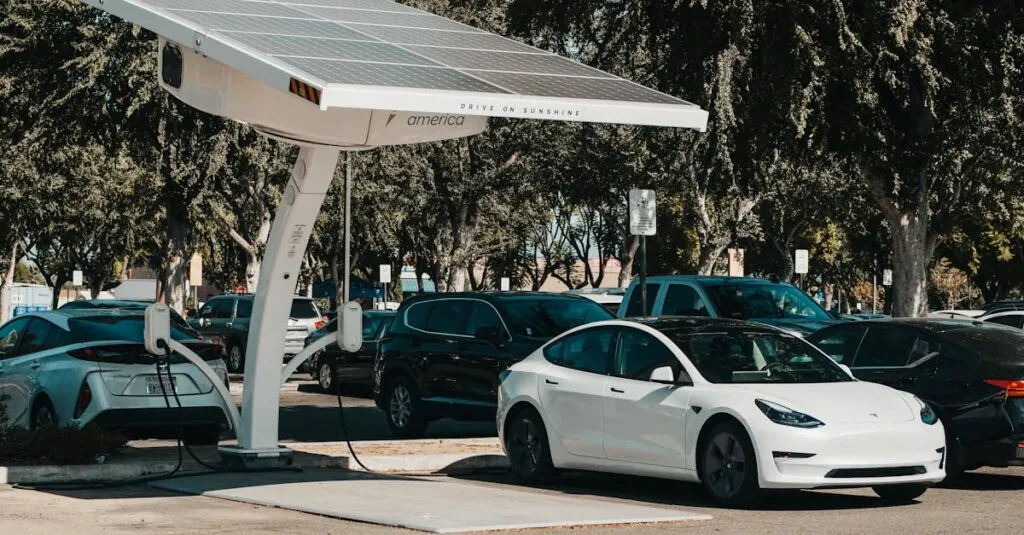Table of Contents
ToggleThe future of transportation is zooming in faster than a kid on a sugar rush. With emerging technologies reshaping how we get from point A to point B, it’s time to buckle up and enjoy the ride. From flying taxis to hyperloop systems, these innovations promise to make commuting not just efficient but downright exciting.
Overview of Emerging Transportation Technologies
Emerging transportation technologies significantly change how people and goods move. Innovations such as autonomous vehicles, flying taxis, and hyperloop systems lead this transformation. Each technology focuses on enhancing speed, efficiency, and sustainability.
Autonomous vehicles use advanced sensors and software to navigate without human intervention. These vehicles increase safety and reduce the number of traffic accidents, making roads more secure. In 2023, autonomous vehicles accounted for about 10 percent of all automotive tech advancements.
Flying taxis, also known as urban air mobility vehicles, promise to deliver passengers through air travel in urban areas. Companies like Joby Aviation and Archer Aviation are making strides in this field. Early prototypes demonstrate that flying taxis can reduce travel time significantly, easing congestion on the ground.
Hyperloop systems hold potential as a high-speed ground transportation solution. Tubes transport pods at speeds exceeding 600 miles per hour. This method not only decreases travel time between cities but also minimizes energy consumption compared to traditional trains and airplanes.
Electric vehicles further contribute to sustainable transportation. They rely on renewable energy sources, which helps reduce greenhouse gas emissions. In 2022, global electric vehicle sales surged, with a reported 6.6 million units sold, reflecting increasing consumer adoption and infrastructure support.
These technologies not only promote eco-friendliness but also prioritize innovation in user experience. Integrating them into urban landscapes presents challenges, yet the potential advantages influence public and private investment. Continued research and development remain critical for overcoming barriers and ensuring successful implementation.
Impact on Urban Mobility
Emerging transportation technologies significantly reshape urban mobility. Innovations enhance efficiency and sustainability in city travel.
Smart Public Transportation Systems
Smart public transportation systems leverage real-time data for improved operations. Cities implement Internet of Things (IoT) technology to monitor traffic patterns and adjust transit schedules. Mobile apps offer riders live updates on bus and train arrivals, increasing convenience. Systems also use predictive analytics to optimize routes based on demand. In 2023, about 60 percent of urban areas planned to upgrade to smart transit solutions, highlighting a commitment to modernization and user satisfaction.
Autonomous Vehicle Integration
Integrating autonomous vehicles into urban settings enhances safety and operational efficiency. Many cities conduct pilot programs to assess the impact of self-driving cars on traffic flow. Collaboration among technology companies and local governments facilitates the development of appropriate infrastructure. In 2023, autonomous vehicles accounted for 10 percent of automotive tech advancements, indicating a growing presence on city streets. Continuous testing aims to refine algorithms for diverse urban scenarios, ultimately improving user experience across transportation modes.
Sustainable Transportation Solutions
Emerging transportation technologies emphasize sustainability, enhancing urban mobility while minimizing environmental impact.
Electric and Hybrid Vehicles
Electric vehicles (EVs) dominate discussions about sustainable solutions. In 2023, around 10 million electric vehicles operate globally, significantly reducing greenhouse gas emissions. Hybrid options also gain traction by combining electric and traditional engines, providing flexibility for drivers. Companies like Tesla and Nissan spearhead innovation in this sector, focusing on longer ranges and faster charging times. Investments in EV infrastructure, such as charging stations, are increasing, with a projected 50 percent growth in installations by the end of the year. Adoption of these vehicles contributes directly to cleaner air and reduced dependence on fossil fuels.
Alternative Fuels and Energy Sources
Alternative fuels represent a crucial strategy for cutting down carbon emissions. Biodiesel, derived from organic materials, and hydrogen fuel cells, offer eco-friendly options for transportation. As of 2023, biodiesel production has increased by 20 percent, actively supporting green initiatives. Hydrogen fuel, used in vehicles like the Toyota Mirai, can power cars with only water as a byproduct. More cities are exploring public transit systems fueled by renewable energy, with approximately 30 percent of transit authorities planning conversions. Overall, these energy sources enhance the sustainability of transportation while addressing climate change challenges.
Challenges and Barriers to Adoption
Emerging transportation technologies face several challenges that hinder their widespread adoption.
Regulatory and Policy Considerations
Regulatory frameworks often lag behind technology advancements. Policymakers struggle to address safety and liability concerns associated with autonomous vehicles and flying taxis. Local governments may hesitate to approve new technologies without comprehensive guidelines. Implementing standards for electric vehicles and alternative fuels remains a complex endeavor, as varied regulations exist across regions. Clarity in policies can directly impact innovation timelines. In 2023, only 30 percent of municipalities have established regulations governing autonomous operations. Without supportive legislation, stakeholders may find it difficult to invest in R&D and operational deployment.
Infrastructure and Investment Needs
Infrastructure must evolve to support new transportation modes. Investments in charging stations and dedicated lanes for electric and autonomous vehicles are crucial. As of 2023, an estimated $50 billion in funding is necessary to upgrade urban transit infrastructures. State and federal investments play a vital role in facilitating these upgrades. Moreover, technology integration requires significant capital for developing smart transportation systems that utilize IoT technology. As a result, various cities are already re-evaluating budgets to accommodate these necessary developments. Failure to secure adequate funding could stall the rollout of these promising technologies.
Future Trends in Transportation Technology
Emerging transportation technologies continuously reshape how society commutes. With innovations on the horizon, the future promises even more transformative developments.
Innovations on the Horizon
Flying taxis and hyperloop systems represent the forefront of transportation innovations. Major companies like Joby Aviation and Archer Aviation pave the way for personal air travel, aiming to cut urban commuting times significantly. Hyperloop systems, employing magnetic levitation technology, offer a high-speed alternative with low energy consumption. Autonomous vehicles also continue evolving, contributing 10 percent of automotive technology advancements in 2023. Electric vehicles thrive as well, with approximately 10 million units on the road globally. They not only reduce greenhouse gas emissions but also push for advancements in battery technology and charging infrastructure.
Role of AI and Data Analytics
Artificial intelligence and data analytics play a crucial role in optimizing transportation systems. Smart public transportation systems utilize real-time data to enhance efficiency, with about 60 percent of urban areas implementing upgrades in 2023. Predictive analytics helps forecast demand, allowing for better route planning and resource allocation. Pilot programs exploring autonomous vehicle integration focus on traffic flow improvement and user experience enhancement. IoT technology aids in collecting data from various sensors, providing insights into urban mobility patterns. Continuous collaboration between technology companies and local governments ensures infrastructure aligns with these advancements.
The landscape of transportation is rapidly evolving with groundbreaking technologies that promise to redefine how people move within urban environments. Innovations like flying taxis and hyperloop systems are not just futuristic dreams; they’re on the verge of becoming reality. As cities invest in smart public transportation and sustainable solutions, the emphasis on efficiency and eco-friendliness grows stronger.
However, challenges remain in regulatory frameworks and infrastructure development. The success of these emerging technologies hinges on collaboration between tech companies and local governments. With ongoing investments and research, the future of urban mobility looks promising, paving the way for safer and more sustainable travel options. The journey toward smarter transportation is just beginning, and its potential is limitless.




